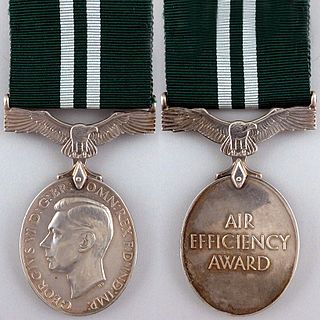
The Air Efficiency Award, post-nominal letters AE for officers, was instituted in 1942. It could be awarded after ten years of meritorious service to officers, airmen and airwomen in the Auxiliary and Volunteer Air Forces of the United Kingdom and the Territorial Air Forces and Air Force Reserves of the Dominions, the Indian Empire, Burma, the Colonies and Protectorates.
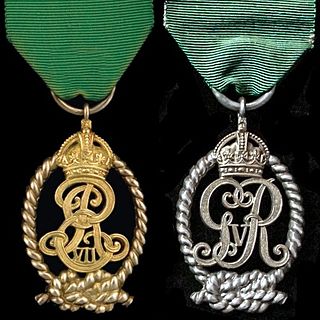
The Decoration for Officers of the Royal Naval Volunteer Reserve, post-nominal letters VD until c. 1947 and VRD thereafter, was instituted in 1908. It could be awarded to part-time commissioned officers in the United Kingdom's Royal Naval Volunteer Reserve after twenty years of service as efficient and thoroughly capable officers. The decoration was a Naval version of the Volunteer Officers' Decoration and its successor, the Territorial Decoration.
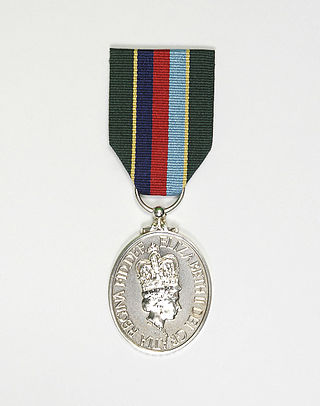
The Volunteer Reserves Service Medal (VRSM) is a medal which may be awarded to members of the Volunteer Reserves of all branches of the British Armed Forces - the Royal Naval Reserve, the Royal Marines Reserve, the Army Reserve and the Royal Auxiliary Air Force. It replaced the separate decorations and medals awarded respectively to officers and other ranks in each of the services - the Royal Navy's Reserve Decoration and Reserve Long Service and Good Conduct Medal, the British Army's Territorial Decoration and Efficiency Medal, and the Royal Air Force's Air Efficiency Award - from 1 April 1999.

The Decoration for Officers of the Royal Naval Reserve, commonly known as the Reserve Decoration (RD) was a medal awarded to officers with at least fifteen years service in the Royal Naval Reserve (RNR) of the United Kingdom. The medal was instituted in 1908.
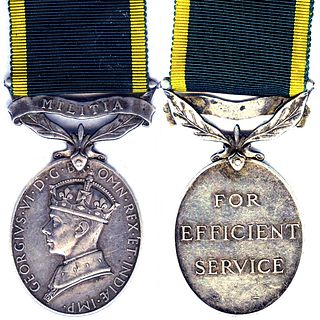
The Efficiency Medal was instituted in 1930 for award to part-time warrant officers, non-commissioned officers and men after twelve years of efficient service on the active list of the Militia or the Territorial Army of the United Kingdom, or of the other Auxiliary Military Forces throughout the British Empire. At the same time a clasp was instituted for award to holders of the medal upon completion of further periods of six years of efficient service.
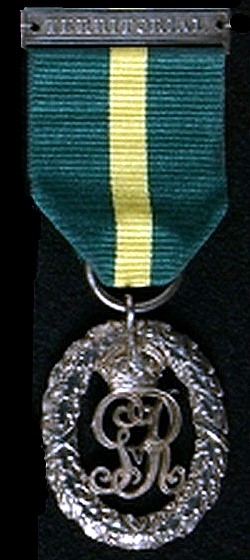
The Efficiency Decoration, post-nominal letters TD for recipients serving in the Territorial Army of the United Kingdom or ED for those serving in the Auxiliary Military Forces, was instituted in 1930 for award to part-time officers after twenty years of service as an efficient and thoroughly capable officer. The decoration superseded the Volunteer Officers' Decoration, the Colonial Auxiliary Forces Officers' Decoration and the Territorial Decoration.
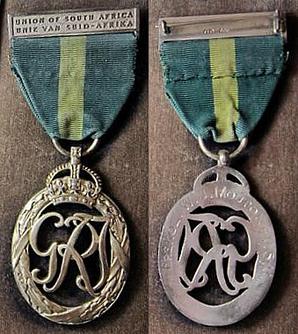
The Efficiency Decoration (South Africa), post-nominal letters ED, was instituted in 1930 for award to efficient and thoroughly capable part-time officers in the Citizen Force of the Union of South Africa after twenty years of service. The decoration superseded the Colonial Auxiliary Forces Officers' Decoration.

The Efficiency Medal (South Africa) was instituted in 1930 for award to part-time warrant officers, non-commissioned officers and men after twelve years of efficient service on the active list of the Citizen Force of the Union of South Africa. At the same time, a clasp was instituted for award to holders of the medal upon completion of further periods of six years of efficient service. The medal superseded the Colonial Auxiliary Forces Long Service Medal.
The Long Service and Good Conduct Medal is a military award recognizing 14 years of exemplary and unblemished service by non-commissioned and other ranks members of the New Zealand Defence Force. Established in 1985, these medals replaced the British Long Service and Good Conduct Medals with specific versions for New Zealand. There are three version of the Long Service and Good Conduct Medal, one each for the New Zealand Army, Royal New Zealand Navy, and the Royal New Zealand Air Force.

The Royal Naval Volunteer Reserve Long Service and Good Conduct Medal, initially designated the Royal Naval Volunteer Reserve Long Service Medal, was instituted in 1908. It could be awarded to part-time ratings in the United Kingdom's Royal Naval Volunteer Reserve after twelve years of service and good conduct. The medal was a Naval version of the Volunteer Long Service Medal and its successor, the Territorial Force Efficiency Medal.

The Permanent Forces of the Empire Beyond the Seas Medal is a long service and good conduct medal, instituted for award to other ranks of the Permanent Forces of the Dominions and Colonies of the British Empire. The medal, also known as the Permanent Overseas Forces Long Service and Good Conduct Medal, was established in 1910 as a single common award to supersede the several local versions of the Army Long Service and Good Conduct Medal which were being awarded by the various territories.

The Militia Long Service Medal was a long service medal awarded by the United Kingdom between 1904 and 1930.

H.M. Coastguard Long Service and Good Conduct Medal is a long service medal awarded by the United Kingdom. Awarded for twenty years full or part-time service, with members of His Majesty's Coastguard, Coastguard Rescue Service, Isle of Man Coastguard and auxiliary coastguards eligible.

In May 1895, Queen Victoria authorised Colonial governments to adopt various British military medals and to award them to their local military forces. The Cape of Good Hope introduced this system in September 1895 and, in 1896, instituted the Army Long Service and Good Conduct Medal (Cape of Good Hope).
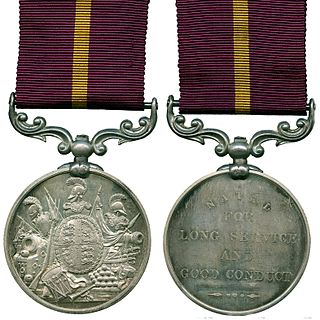
In May 1895, Queen Victoria authorised Colonial governments to adopt various British military medals and to award them to their local military forces. The Colony of Natal introduced this system in August 1895 and, in 1897, instituted the Army Long Service and Good Conduct Medal (Natal).

The Naval Long Service and Good Conduct Medal (1848) is a long service medal awarded to regular members of His Majesty's Naval Service. It was instituted by Queen Victoria to replace the Naval Long Service and Good Conduct Medal (1830), and could be awarded to other ranks and men serving in the Royal Navy and Royal Marines. Since 2016, after a number of changes in eligibility, all regular members of the Royal Navy and Royal Marines who have completed fifteen years of reckonable service can be awarded the medal.

The Colonial Auxiliary Forces Long Service Medal was instituted by Queen Victoria in 1899 as a military long service award for part-time members of all ranks in any of the organized military forces of the British Colonies, Dependencies and Protectorates throughout the British Empire. The medal gradually superseded the Volunteer Long Service Medal for India and the Colonies in all these territories, with the exception of the Isle of Man, Bermuda and the Indian Empire.

The Naval Good Shooting Medal is a Naval gunnery medal that was instituted in 1902, for award to the gunner on each type of ship's gun in the fleet who achieved first place in the gunnery competitions held during the Annual Fleet Competitions. From 1903 to 1914 medals were awarded annually, until the competition was discontinued upon the outbreak of the First World War.

The Volunteer Long Service Medal was instituted in 1894 as an award for long service by other ranks and some officers of the United Kingdom's Volunteer Force. In 1896, the grant of the medal was extended to other ranks and officers who had served in the ranks of the Volunteer Forces throughout the British Empire. A separate new medal was instituted, the Volunteer Long Service Medal for India and the Colonies. Awarding of this medal was discontinued in stages when it was superseded in most territories by the Colonial Auxiliary Forces Long Service Medal in 1899 and in the remainder by the Efficiency Medal in 1930.
The Central Chancery of the Orders of Knighthood has, at irregular intervals, notified for general information the positioning of the wearing of Orders, decorations, and medals of the United Kingdom in the London Gazette. The Order of Wear was last published in 2019.


















